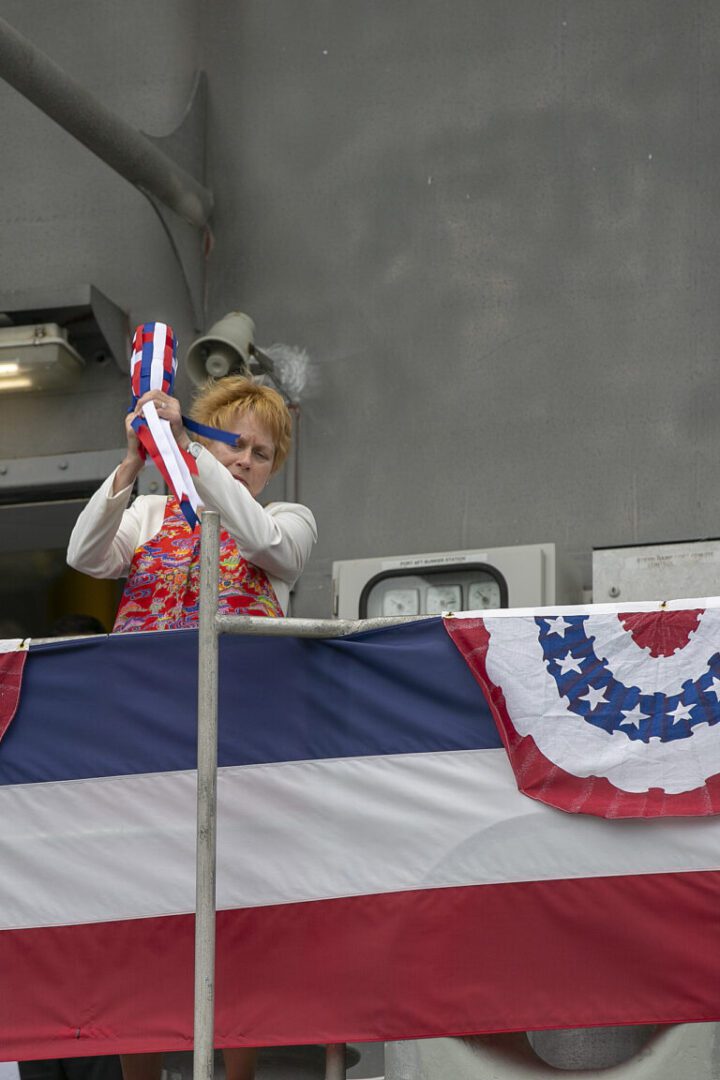
USNS Guam (T HST 1) Christened
Bruni Bradley, sponsor to Military Sealift Command’s high-speed transport USNS Guam (T-HST 1), breaks a bottle during the christening ceremony of USNS Guam, April 27. Bradley, a 25-year Navy veteran, officially declared the Guam christened after breaking a bottle of sparkling wine against the ship’s side railing of the main deck. (Navy photo by Grady T. Fontana/Released)
(Article appears courtesy of Grady Fontana, Military Sealift Command Far East)G
Military Sealift Command (MSC) christened the high-speed transport USNS Guam (T-HST 1) during a ceremony at Naha Military Port in Naha, Japan, April 27.
Key speakers were U.S. Ambassador to South Korea Harry B. Harris Jr.; Guam Rep. Michael San Nicholas; Lt. Gen. Eric M. Smith, commanding general, III Marine Expeditionary Force (III MEF); Rear Adm. Robert T. Clark, deputy commander of MSC; and USNS Guam’s sponsor, Mrs. Bruni Bradley, a 25-year Navy veteran and wife of Harris.
“The Navy has a glorious history of naming ships after heroes, epic battles and key places in the U.S.; and this ship is no exception,” said Ambassador Harris, who is also a former Navy Admiral. “Guam is the site of one of the bloodiest battles in the Pacific campaign (of World War II).
“Although most of the greatest generation are no longer with us, we can hear their stories of duty, honor and courage. Their spirits walk among us, and with us, and call out to us. Today, we’ve answered their call with an innovative ship, which serves as a reminder of their heroism and a tribute to a beautiful place called Guam, U.S.A,” said Harris in a speech.
The ceremony was capped by a time-honored tradition, when Bradley officially declared the Guam christened prior to breaking a bottle of sparkling wine against the ship’s side railing of the main deck.
The Guam was acquired by the Navy from the Department of Transportation in 2012 and underwent renovations before it became operational in late 2017 when it replaced the Westpac Express as a III MEF asset.
Earlier plans to christen the ship in Guam were thwarted by unforeseen typhoons in the region and a high tempo by the ship’s schedulers. Due to additional operational requirements on the ship, effort to have the christening in Guam was not possible.
USNS Guam is an aluminum catamaran designed to be fast, flexible and maneuverable, even in austere port conditions, making the vessel ideal for transporting troops and equipment quickly.
According to Smith, the value of USNS Guam to the III MEF is that the ship can be quickly reconfigured for any cargo requirement: from supporting humanitarian assistance and disaster relief; to transporting Marines, Sailor and equipment throughout the Indo-Pacific theater.
“This ship is vital to us,” said Smith in a speech. “It carries the most precious cargo that there is…the Marines and Sailors of the III MEF.”
The USNS Guam is preceded in service by the patrol gunboat USS Guam (PG 43), which was renamed Wake in 1941 and captured by the Japanese later that year, the Alaska-class large cruiser USS Guam (CB 2) in service 1944-1947, and the Iwo Jima-class amphibious assault ship USS Guam (LPH 9) in service 1965-1998.
Tags:
